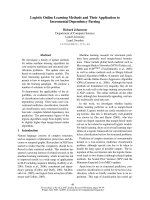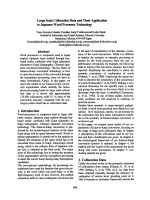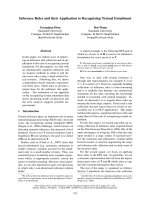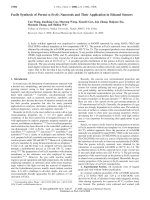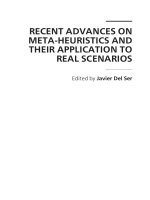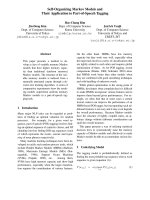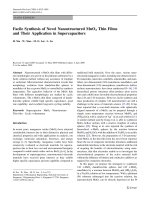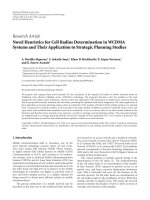remainder diffential algebras and their application makino
Bạn đang xem bản rút gọn của tài liệu. Xem và tải ngay bản đầy đủ của tài liệu tại đây (268.3 KB, 13 trang )
5. Remainder Differential Algebras and Their Applications
∗
(Chapter of “Computational Differen tiation: Techniques, Applications, and Tools”,
Martin Berz, Christian Bischof, George Corli ss, and Andreas Griewank, eds., SIAM, 1996.)
Kyok o Makino
†
Martin Berz
†
Abstract
In many practical problems in which derivatives are calculated, their basic purpose
is to be used in the modeling of a functional dependence, often based on a Taylor
expansion t o first or higher orders. While the practical computation of such derivatives
is greatly facilitated and in many cases is possible only through the use of forward or
rev erse computational differentiation, there is usually no direct information regarding
the accuracy of the functional model based on the Taylor expansion.
We show how, in parallel to the accumulation of deriva tives, error bounds of all
functional dependencies can be carried along the computation. The additional effort is
minor, and the resulting bounds are u sually rather sharp, in particular at higher orders.
This Remainder Differential Algebraic Method is more straightforward and can yield
tigh ter bounds than the mere in terval bounding of the Taylor remainder’s (n +1)st
order derivative obtained via forward differentiation.
The method can be applied to various numerical problems: Here we focus on g lobal
optimization, where blow-up can often be substantially reduced compared with interval
methods, in particular for the cases of complicated functions or many variables. This
problem is at the core of many questions of nonlinear dynamics and can help facilitate
a detailed, quantitative understanding.
Keywords: Remainder differential algebras, differential algebras, error bound,
in terval method, high-order derivatives, Taylor polynomial, Taylor remainder, beam
physics, COSY INFINITY, Fortran precompiler.
1Introduction
The significant advances in computer hardware that we have experienced particularly
in the past decade allow the study of ever more complex problems. In many practical
problems, one must locally model nonlinear functional dependencies, for e xample to
study parameter sensitivity or to perform optimization. This is typically done through
the computation of derivatives, and the forward and reverse modes of computational
differentiation [Griewank1991e] have excelled in providing such derivatives accurately and
inexpensively.
While the derivatives themselves are accurate except for computational errors that
are t ypically very small, rigor is lost when the derivatives are used to model a functional
dependence, because of the lack of information about the size of remainder terms. The
method of in terval arithmetic (see, for example, [Kulisch1981a]) often provides a means for
keeping the mathematical rigor in the computation of model functions. However, the naive
use of interval methods in large problems is prone to blow-up, whi ch at times limits the
practical usefulness o f suc h methods.
∗
This research was financially supported by the Department of Energy, Grant No. DE-FG02-95ER40931,
and the Alfred P. Sloan Foundation.
†
Departmen t of Physics and Astronomy, Michigan State U niversity, East Lansing, MI 48824, USA,
(, ).
63
64 Makino and Berz
In this paper, we discuss a combination of the techniques of computational differen-
tiation and interval methods, in a way that uses the advantages and diminishes the dis-
advantages of either of the two m ethods. The new technique, the method of Remainder
Differential Algebras, employs high-order computational differentiation [Berz1991a] to ex-
press the model function by a Taylor polynomial, and in terval computation to evaluate the
Taylor remainder error bound.
For example, in beam physics and weakly nonlinear dynamics in gener al, the D ifferential
Algebraic technique [Berz1989a], [Berz1990e], [Berz1991d], [Berz1994b] has o ffered a
remarkably robust way to study the nonlinear behavior of beams and has evolved into one of
the essential tools. However, many difficult yet important questions remain, including the
long-term stability of beams in circular accelerators or other dynamical systems, such as the
planets in the solar system. In light of modern stability theories, this problem c an be cast
as an optimization problem [Berz1994c], [Berz1996b], which from the computational point
of view is very complex. The method of Remainder Differential Algebras as an extension
of conventional Differential Algebraic techniques may shed light on this and many other
questions requiring verified computations of complicated problems [Berz1996 b].
2 Remainder Differential Algebras
In this section, we pro vide an overview of the method of computing remainder terms along
with the original function. The Taylor theorem plays an important role in this endeavor,
and we briefly state it here.
Theorem 2.1 (Taylor’s Theorem). Suppose that a f unction f :[a,
b] ⊂ R
v
→ R is
(n +1) times partially differentiable on [a,
b]. Assume x
0
∈ [a,
b]. Then for each x ∈ [a,
b],
there is θ ∈ R with 0 <θ<1 such that
f(x)=
n
X
ν=0
1
ν!
³
(x − x
0
) ·
∇
´
ν
f(x
0
)+
1
(n +1)!
³
(x − x
0
) ·
∇
´
n+1
f (x
0
+(x − x
0
)θ) ,
where the partial differential operator
³
h ·
∇
´
k
operates as
³
h ·
∇
´
k
=
X
0 ≤ i
1
, ···,i
v
≤ k
i
1
+ ···+ i
v
= k
k!
i
1
! ···i
v
!
h
i
1
1
···h
i
v
v
∂
k
∂x
i
1
1
···∂x
i
v
v
.
Depending on the situation at hand, the remainder term also can be cast into a variety
of other forms. Taylor’s theorem allows a quantitative estimate of the error that is to be
expected when approximating a function by its Taylor polynomial. Furthermore, it even
offers a way to obtain bounds for the error in practice, based on bounding the (n +1)st
derivative, a method that has been employed in interval calculations.
Roughly speaking, Taylor’s theorem suggests that in many cases the error decreases
with the order as the width of the interval raised to the order being considered, and its
practical use is often connected to this observation. However, certain examples illustrate
that this behavior does not have to occur; one such example is in the following section.
For notational convenience, we in troduce a parameter α to desc ribe the details of a
given Taylor expansion, namely, the order of the Taylor polynomial n, the reference point
of expansion x
0
, and the domain interval [a,
b] on which the function is to be considered as
α =(n, x
0
, [a,
b]).(1)
5. Remainder Differential Algebras and Applications 65
With the help of Taylor’s theorem, any (n + 1) times partially differentiable function
f :[a,
b] ⊂ R
v
→ R canbeexpressedbytheTaylorpolynomialP
α,f
of nth order and
a remainder ε
α,f
. We write it symbolically as
f(x)=P
α,f
(x − x
0
)+ε
α,f
(x − x
0
),
where ε
α,f
(x −x
0
) is continuous on the domain interval and thus bounded. Let the interval
I
α,f
be such that for any x ∈ [a,
b], ε
α,f
(x − x
0
) ∈ I
α,f
.Then
∀x ∈ [a,
b],f(x) ∈ P
α,f
(x − x
0
)+I
α,f
.(2)
Because of the special form of the Taylor remainder term ε
α,f
, in practice the remainder
usually decreases as |x − x
0
|
n+1
.Hence,if|x − x
0
| is chosen to be small, the interval I
α,f
,
whic h from now on we refer to as the interval remainder bound, can become very small.
The set P
α,f
(x − x
0
)+I
α,f
containing f consists of the Taylor polynomial P
α,f
(x − x
0
)
and the interval remainder bound I
α,f
.Wesayapair(P
α,f
,I
α,f
) of a Taylor polynomial
P
α,f
(x − x
0
) and an interval remainder bound I
α,f
is a Taylor model of f if and only if (2)
is satisfied. In this case, we denote the Taylor model by
T
α,f
=(P
α,f
,I
α,f
).
We call n the order of the Taylor model, x
0
the reference point of the Taylor model, [a,
b]
the domain interva l of the Taylor model, and α the parameter of the Taylor model.
In the following, we develop tools that allow us to calculate Taylor models for all
functions representable on a computer.
2.1 Differential Algebras and In terval Arithmetic
In the preceding section, the concept of Remainder Differential Algebras and Taylor models
was introduced. While the computational i dea of Taylor models is unique, the two
constituents of a Taylor model, namely, the Taylor polynomial and the bounding interval,
are familiar concepts.
While computational differentiation tec hniques focus mostly on first- or low-order
derivatives, some algorithms [Berz1991a] and codes allow the computation of very high-
order derivatives [Berz1990d], [Berz1990a], [Berz1994b], [Berz1995a]. This a pplication has
received attention recently in the field of beam physics in a differential algebraic frame-
work suited for treatment of differen tial equations [Berz1992a], [Berz1993a], [Berz1995a],
[Berz1996b].
While these methods can provide the derivatives of the function to high orders, they
fail to provide rigorous information about the range of the function. A simple example that
dramatically illustrates this phenomenon is the function
f(x)=
(
exp(−1/x
2
)ifx 6=0
0ifx =0.
The value of the function and all the derivatives at x = 0 are 0. Thus the Taylor polynomial
at the reference point x = 0 is just the constant 0. In particular, this also implies that the
Taylor series of f converges everywhere, but it fails to agree with f(x) everywhere but at
x =0.
In a situation such as this one, the methods of interval arithmetic make a contrast.
Interval arithmetic carries the information of rigorous bounds of a function in computation,
Edited by Foxit Reader
Copyright(C) by Foxit Software Company,2005-2008
For Evaluation Only.
66 Makino and Berz
and the computation time is usually reasonably fast. However, the poten tial problem of
blow-up always exists. To illustrate this phenomenon with a trivial example, we consider
the interval I =[a, b], which has the width b − a. We compute the addition of I to itself
and its subtraction from itself: I + I =[2a, 2b]andI − I =[a − b, b − a]. In both cases
the resulting width is 2(b − a) and is twice the original width, although we know that
regardless of what unknown quantity x is characterized by I, certainly x − x should equal
zero. Similar blow-up often poses a severe problem f or interval methods, in particular
when the underlying functions become very complex. In the case of Remainder Differential
Algebras, however, the remainder bound intervals are kept so small that even the effect of
considerable blow-up is not detriment al.
2.2 Addition and Mult iplication of Taylor Models
In this section, we discuss how a Taylor model of a sum or product of two functions can be
obtained from the Taylor models of the two individual functions. This represents the first
step toward the computation of Taylor models for any function that can be represen ted on
a computer.
Let the functions f, g :[a,
b] ⊂ R
v
→ R have Taylor models
T
α,f
=(P
α,f
,I
α,f
)andT
α,g
=(P
α,g
,I
α,g
),
which entails that
∀x ∈ [a,
b],f(x) ∈ P
α,f
(x − x
0
)+I
α,f
and
g(x) ∈ P
α,g
(x − x
0
)+I
α,g
.
Then it is straightforward to obtain a Taylor model for f + g; in fact, for any x ∈ [a,
b],
f(x)+g(x) ∈ (P
α,f
(x − x
0
)+I
α,f
)+(P
α,g
(x − x
0
)+I
α,g
)
=(P
α,f
(x − x
0
)+P
α,g
(x − x
0
)) + (I
α,f
+ I
α,g
),
so that a Taylor model T
α,f+g
for f + g can be obtained via
P
α,f +g
= P
α,f
+ P
α,g
and I
α,f+g
= I
α,f
+ I
α,g
.(3)
Thus we define
T
α,f
+ T
α,g
=(P
α,f
+ P
α,g
,I
α,f
+ I
α,g
),
and w e obtain that T
α,f
+ T
α,g
=(P
α,f +g
,I
α,f +g
) is a Taylor model for f + g.Notethat
the above addition of Taylor models is both commutative and associative.
The goa l in defining a multiplication of Taylor models is to determine a Taylor m odel
for f · g from the knowledge of the Taylor models T
α,f
and T
α,g
for f and g. Observe that
for any x ∈ [a,
b],
f(x) · g(x) ∈ (P
α,f
(x − x
0
)+I
α,f
) · (P
α,g
(x − x
0
)+I
α,g
)
⊆ P
α,f
(x − x
0
) · P
α,g
(x − x
0
)
+P
α,f
(x − x
0
) · I
α,g
+ P
α,g
(x − x
0
) · I
α,f
+ I
α,f
· I
α,g
.
Note that P
α,f
· P
α,g
is a polynomial of (2n)th order. We split it into the part of up to
nth order, which agrees with the Taylor polynomial P
α,f ·g
of order n of f · g,andtheextra
polynomial P
e
,sothatwehave
P
α,f
(x − x
0
) · P
α,g
(x − x
0
)=P
α,f ·g
(x − x
0
)+P
e
(x − x
0
).(4)
5. Remainder Differential Algebras and Applications 67
ATaylormodelforf · g can now be obtained by finding an interval bound for all the terms
except P
α,f ·g
. For this purpose, let B(P)beaboundofthepolynomialP :[a,
b] ⊂ R
v
→ R,
namely,
∀x ∈ [a,
b],P(x) ∈ B(P ).
Apparently the efficient practical determination of B(P) is not completely trivial; depending
on the order and number of variables, different strategies may be employed, ranging from
analytical estimates to interval eva luations. However, thanks to the specific circumstances,
the occurring contributions are very small, and even moderate overestimation is not
immediately critical.
Altogether, an interval remainder bound for f · g can be found via
I
α,f·g
= B(P
e
)+B(P
α,f
) · I
α,g
+ B(P
α,g
) · I
α,f
+ I
α,f
· I
α,g
.(5)
Thus we define T
α,f
· T
α,g
=(P
α,f ·g
,I
α,f·g
),andobtainthatT
α,f
· T
α,g
is a Taylor model
for f · g. Note that commutativity of m u ltiplication holds, T
α,f
· T
α,g
= T
α,g
· T
α,f
,while
multiplication is not generally associative, and also d istributivity does not generally hold.
While the idea of Taylor models of constant functions i s almost trivial, we mention it
for the sake of completeness. For a constant function f(x) ≡ t, the Taylor model of f is
T
α,f
≡ T
α,t
=(P
α,t
,I
α,t
)=(t, [0, 0]).
Having introduced addition and multiplication as well as scalar multiplication, we can
compute any polynomial of a Taylor model. Let Q(f) be a polynomial of a function f,that
is, Q(f)=t
0
+ t
1
f + t
2
f
2
+ ···+ t
k
f
k
. In practice it is useful to evaluate Q(f) via Horner’s
sc heme,
Q(f)=t
0
+ f ·
µ
t
1
+ f ·
³
t
2
+ f · (···(t
k−1
+ f · t
k
) ···)
´
¶
,
in order to minimize operations. Assume that we have already found the Taylor model
of the function f to be T
α,f
=(P
α,f
,I
α,f
). Then, using additions and multiplications of
Taylor models described above, we can compute a Taylor model for the function Q(f)via
T
α,Q(f )
=
³
P
α,Q(f)
,I
α,Q(f)
´
.
2.3 Functions in Remainder Differential Algebras
In the preceding section, we showed how Taylor models for sums and products of functions
can be obtained from those of the individual functions. The computation led to the
definition of addition and multiplication of Taylor models. Here w e study the computation
of Taylor models for intrinsic functions, including the reciprocal applied to a given function
f from the Taylor model of f.
The key idea is to employ Taylor’s theorem of the function under consideration:
However, in order to ensure that the resulting remainder term yields a small remainder
interval and does not contribute anything to the Taylor polynomial, some additional
manipulations are necessary.
Let us begin the study with the exponential function. Assume that we have already
found the Tay lor model of the function f to be T
α,f
=(P
α,f
,I
α,f
). Write the constant
part of the function f around x
0
as c
α,f
, which agrees with the constant part of the Taylor
polynomial P
α,f
, and write the remaining part as
¯
f,thatis,
f(x)=c
α,f
+
¯
f(x).
Edited by Foxit Reader
Copyright(C) by Foxit Software Company,2005-2008
For Evaluation Only.
68 Makino and Berz
ATaylormodelof
¯
f is then T
α,
¯
f
=(P
α,
¯
f
,I
α,
¯
f
), where
P
α,
¯
f
(x − x
0
)=P
α,f
(x − x
0
) − c
α,f
and I
α,
¯
f
= I
α,f
.
Now we can write
exp(f(x)) = exp
¡
c
α,f
+
¯
f(x)
¢
=exp(c
α,f
) · exp
¡
¯
f(x)
¢
=exp(c
α,f
) ·
½
1+
¯
f(x)+
1
2!
(
¯
f(x))
2
+ ···+
1
k!
(
¯
f(x))
k
+
1
(k +1)!
(
¯
f(x))
k+1
exp
¡
θ ·
¯
f(x)
¢
¾
,
where 0 <θ<1. Taking k ≥ n,wheren is the order of Taylor model, the part
exp(c
α,f
) ·
½
1+
¯
f(x)+
1
2!
(
¯
f(x))
2
+ ···+
1
n!
(
¯
f(x))
n
¾
is a polynomial of
¯
f, of which w e can obtain the Taylor model as outlined in the preceding
section. The remainder part of e xp(f(x)),
exp(c
α,f
) ·
½
1
(n +1)!
(
¯
f(x))
n+1
+ ···+
1
(k +1)!
(
¯
f(x))
k+1
exp
¡
θ ·
¯
f(x)
¢
¾
,(6)
will be bounded by an interval. Since P
α,
¯
f
(x − x
0
) does not have a constant part,
(P
α,
¯
f
(x − x
0
))
m
starts from mth order. Thus, in the Taylor model computation, the
remainder part (6) has vanishing polynomial part. The remainder bound interval for the
Lagrange remainder term
exp(c
α,f
)
1
(k +1)!
(
¯
f(x))
k+1
exp
¡
θ ·
¯
f(x)
¢
can be estimated because, for any x ∈ [a,
b], P
α,
¯
f
(x − x
0
) ∈ B(P
α,
¯
f
), and 0 <θ<1, and so
(
¯
f(x))
k+1
exp
¡
θ ·
¯
f(x)
¢
∈
³
B(P
α,
¯
f
)+I
α,
¯
f
´
k+1
exp
³
[0, 1] · (B(P
α,
¯
f
)+I
α,
¯
f
)
´
.
Since the exponential function is monotonicall y increasing, the estimation of t he interval
bound of the part exp
³
[0, 1] · (B(P
α,
¯
f
)+I
α,
¯
f
)
´
is achieved by inserting the upper and lower
bounds of the argument in the exponential.
A Taylor model for the logarithm of a function f can be computed in a similar manner
from the Taylor model of the function. In this case, there is the limitation that it has
to be ensured that the range of the function f lies entirely within the range of definition
of the logarithm, which will be the case if, for any x ∈ [a,
b], any element in the set
P
α,f
(x −x
0
)+I
α,f
is positive. For the actual computation, we again split the constant part
of the function f around x
0
from the rest f(x)=c
α,f
+
¯
f(x). Then we obtain
log(f(x)) = log
¡
c
α,f
+
¯
f(x)
¢
=log
(
c
α,f
·
Ã
1+
¯
f(x)
c
α,f
!)
=logc
α,f
+log
Ã
1+
¯
f(x)
c
α,f
!
=logc
α,f
+
¯
f(x)
c
α,f
−
1
2
(
¯
f(x))
2
c
2
α,f
+ ···+(−1)
k+1
1
k
(
¯
f(x))
k
c
k
α,f
+(−1)
k+2
1
k +1
(
¯
f(x))
k+1
c
k+1
α,f
1
¡
1+θ ·
¯
f(x)/c
α,f
¢
k+1
,
5. Remainder Differential Algebras and Applications 69
where 0 <θ<1. Taking k ≥ n, the part
log c
α,f
+
¯
f(x)
c
α,f
−
1
2
(
¯
f(x))
2
c
2
α,f
+ ···+(−1)
n+1
1
n
(
¯
f(x))
n
c
n
α,f
is again t reated as a polynomial of
¯
f in the Taylor model computation. The Lagrange
remainder part of log(f(x)) becomes part of the remainder bound interval of the Taylor
model o f log(f). The remainder term can be estimated as
(−1)
k+2
1
k +1
(B(P
α,
¯
f
)+I
α,
¯
f
)
k+1
c
k+1
α,f
1
³
1+[0, 1] · (B(P
α,
¯
f
)+I
α,
¯
f
)/c
α,f
´
k+1
.
In a rather similar fashion, it is possible to determine Taylor models of square roots
and trigonometric functions as soon as a Taylor model f or the argument is known. As a
last example, we determine a Taylor model for the multiplicative in verse from that of the
function. This Taylor model can be computed if and only if, for any x ∈ [a,
b], any element
in the set P
α,f
(x − x
0
)+I
α,f
is nonzero. For the actual computation, we again split the
constant part of the function f around x
0
from the rest as before. Then we obtain
1
f(x)
=
1
c
α,f
+
¯
f(x)
=
1
c
α,f
·
1
1+
¯
f(x)/c
α,f
(7)
=
1
c
α,f
·
(
1 −
¯
f(x)
c
α,f
+
(
¯
f(x))
2
c
2
α,f
− ···+(−1)
k
(
¯
f(x))
k
c
k
α,f
)
+(−1)
k+1
(
¯
f(x))
k+1
c
k+2
α,f
1
¡
1+θ ·
¯
f(x)/c
α,f
¢
k+2
,
where again 0 <θ<1. By choosing k ≥ n, the Taylor model c omputation for the
multiplicative inverse function can be done as before.
Altogether, it is now possible to compute Taylor models for any function that can be
represented in a computer environment by simple operator overloading, in much the same
way as t he mere computation of derivatives, Taylor polynomials, or interva l bounds, along
with the mere evaluation of the function.
For many practical problems, in particular the efficient solution of differential equations,
it is actually important to complement the set of currently available operations by a
derivation ∂ that allows the c omputation of a Taylor model o f the derivative of a function
from that of the original function. As in the case of the con ventional Differential Algebraic
method, in order to prevent loss of order in the differentiation process, the derivation ∂ can
be evaluated only in the context of a Lie derivative L
g
= g·∂,whereg(x
0
)=0. However,in
the case of Taylor models, an additional com p lication is connected to the fact that from the
Taylor model alone, it is impossible to determine a bound for the derivative, s ince nothing
is known about the rate of change of the function (f − P
α,f
) within the remainder bound
I
f
. The situation can be remedied by a further extension of the Taylor model concept to
contain not only bounds for the remainder, but also a low-parameter bounding sequence for
all the higher derivatives that can occur. For reasons of space, we hav e to restrict ourselves
to this outlook as to what is necessary to complete the algebra of Taylor models into a
Remainder Differential Algebra.
Edited by Foxit Reader
Copyright(C) by Foxit Software Company,2005-2008
For Evaluation Only.
70 Makino and Berz
3Examples
Remainder Differential Algebras have many applications, including global optimization,
quadrature, and solution of differential equations. We begin our discussion with the
determination of a sharp bound for a simple example function using Remainder Differential
Algebras. The sharpness of the resulting bound will be compared with the results that can
be obtained in other ways. The function under consideration is
f(x)=
1
x
+ x.(8)
For an actual computation, we set the parameter α of (1) to α =(n, x
0
, [a, b]) =
(3, 2, [1.9, 2.1]).
As in the case of conventional forward differentiation, the evaluation begins with the
representation of the identity function, expressed in t erms of a Ta ylor polynomial expanded
at the reference point. This identity function i has t he form
i(x)=x = x
0
+(x − x
0
)=2+(x − 2).
Since this representation is exact, the remainder bound is [0, 0]. Hence, a Taylor model of
the identity f unction i is
T
α,i
=(x
0
+(x − x
0
), [0, 0]) = (2 + (x − 2) , [0, 0]).
The constant part of i around x
0
=2isc
α,i
= x
0
= 2, and the nonconstant part of i is
¯
i(x)=x − x
0
= x − 2. The Taylor model of
¯
i is
T
α,
¯
i
=((x − x
0
), [0, 0]) = ((x − 2), [0, 0]) .
The computation of the inverse requires the knowledge of a bound of P
α,
¯
i
, which here is
readily obtained: B(P
α,
¯
i
)=B(x − x
0
)=[a− x
0
,b− x
0
]=[−0.1, 0.1]. Wehavefurthermore
B(P
α,
¯
i
)+I
α,
¯
i
=[−0.1, 0.1] + [0, 0] = [−0.1, 0.1]. Using (4) and (5), we have for the Taylor
model of (
¯
i)
2
T
α,(
¯
i)
2
=
³
(x − 2)
2
, [0, 0]
´
.
The Taylor model of (
¯
i)
3
is computed similarly: T
α,(
¯
i)
3
=
¡
(x − 2)
3
, [0, 0]
¢
. As can be seen,
so far all rem ainder intervals are of zero size. The first nonzero remainder interval comes
from the evaluation of the Taylor remainder term, which is
(
¯
i(x))
4
c
5
α,i
1
(1 + θ ·
¯
i(x)/c
α,i
)
5
∈
(B(P
α,
¯
i
)+I
α,
¯
i
)
4
x
5
0
·
³
1+[0, 1] · (B(P
α,
¯
i
)+I
α,
¯
i
)/x
0
´
5
(9)
⊆
[0, 0.0001]
2
5
· ([0.95, 1.05])
5
⊆ [0, 4.038 × 10
−6
].
As expected, this remainder term is “small of order four”. According to (7), the Taylor
model of 1/i is then
T
α,
1
i
=
µ
1
2
−
1
2
2
(x − 2) +
1
2
3
(x − 2)
2
−
1
2
4
(x − 2)
3
, [0, 4.038 × 10
−6
]
¶
,
5. Remainder Differential Algebras and Applications 71
Table 1
The remainder bound interval I
α,1/i+i
for various orders; x
0
=2, [a, b]=[1.9, 2.1]
Order The remainder bound interval
1 [0,1.4579384 × 10
−3
]
2 [ −7.6733603 × 10
−5
,7.6733603 × 10
−5
]
3 [0,4.0386107 × 10
−6
]
4 [ −2.1255845 × 10
−7
,2.1255845 × 10
−7
]
5 [0,1.1187287 × 10
−8
]
6 [ −5.8880459 × 10
−10
,5.8880459 × 10
−10
]
7 [0,3.0989715 × 10
−11
]
8 [ −1.6310376 × 10
−12
,1.6310376 × 10
−12
]
9 [0,8.5844087 × 10
−14
]
10 [ −4.5181098 × 10
−15
,4.5181098 × 10
−15
]
11 [0,2.3779525 × 10
−16
]
12 [ −1.2515539 × 10
−17
,1.2515539 × 10
−17
]
13 [0,6.5871262 × 10
−19
]
14 [ −3.4669085 × 10
−20
,3.4669085 × 10
−20
]
15 [0,1.8246887 × 10
−21
]
and the remainder in t erval is indeed still very sharp. U sing (3), we obtain as the final
Taylor model of 1/i + i
T
α,
1
i
+i
= T
α,
1
i
+ T
α,i
=
³
P
α,
1
i
+i
,I
α,
1
i
+i
´
(10)
=
µµ
2+
1
2
¶
+
µ
1 −
1
2
2
¶
(x − 2) +
1
2
3
(x − 2)
2
−
1
2
4
(x − 2)
3
, [0, 4.038 × 10
−6
]
¶
=
³
2.5+0.75(x − 2) + 0.125(x − 2)
2
− 0.0625(x − 2)
3
, [0, 4.038 × 10
−6
]
´
.
Since the polynomial P
α,
1
i
+i
is monotonically increasing in the domain [a, b]=[1.9, 2.1],
the bound interval of the polynomial is
B
³
P
α,
1
i
+i
´
=
h
P
α,
1
i
+i
(−0.1),P
α,
1
i
+i
(0.1)
i
=[2.42631, 2.57618].
The width of the bound interval of the Taylor polynomial is 0.14987, and t he width of the
interval of the remainder bound is 4.038 × 10
−6
in the third-order Taylor model evaluation;
thus the remainder part is just a minor addition. The size of this remainder bound depends
strongly on the order and decreases quickly with order. Ta ble 1 shows the remainder bound
interval for various orders in the Taylor model computation.
The Taylor model computation is assessed by noting the bound interval B of the original
function (8), which is
B
µ
1
x
+ x
¶
=
∙
1
a
+ a,
1
b
+ b
¸
=[2.42631, 2.57619].
It i s illuminating to compare the sharpness of the bounding of the function with the
sharpness that can be obtained from conventional interval methods. Evaluating the function
with just one interval yields
1
[a, b]
+[a, b]=
1
[1.9, 2.1]
+[1.9, 2.1] ⊆ [2.37619, 2.62631].
72 Makino and Berz
Table 2
The width of the bound interval of f(x)=1/x + x by various methods; x
0
=2, [a, b]=[1.9, 2.1]
Method Width of Bound Interval
Intervals n
d
=1 0.25012531
n
d
=10 0.15993589
n
d
=10
2
0.15088206
n
d
=10
3
0.14997543
n
d
=10
4
0.14988476
n
d
=10
5
0.14987569
n
d
=10
6
0.14987478
n
d
=10
7
0.14987469
n
d
=10
8
0.14987468
Taylor models 1st order 0.15145793
2nd order 0.15015346
3rd order 0.14987903
4th o rder 0.14987542
5th o rder 0.14987469
6th o rder 0.14987468
Exact 0.14987468
The width of the bound interval obtained by interval arithmetic is 0.25012, and so this
simple example already shows a noticeable blow-up. By dividing the domain interval into
many subintervals, the blow-up can be suppressed substantially. However, to achieve
the sharpness of the third-order Taylor model, the domain h as to be split into about
24, 000 subintervals. Table 2 shows a comparison of the widths of bound interval for the
exact value, the method of Taylor models, and the divided interval method, w here n
d
indicates the number of division of the domain interval. Of course, sophisticated interval
optimization methods [Hansen1979a], [Hansen1988a], [Ic hida1979a], [Jansson1992a] can
find sharp bounds for the function using substantially fewer interval evaluations.
Practically more important are optimizationproblemsinseveralvariables,andinthis
case, the situation becomes more dramatic. We wish first to illustrate the computational
effort necessary for an accurate calculation of the result by estimating the required n umber
of floating-point o perations. We use a simple example function of six variables such as
f(x)=
P
j
(1/x
j
+ x
j
) t o get a rough idea of the computational expense in the case
of functions of many variables. In the one-dimensional case, one interval calculation
1/[a, b]+[a, b] requires two additions and two divisions. To compare with the third-
order Taylor model computation, we divide the domain into 10
4
subintervals, on which
additions and divisions total ∼10
5
floating-point operations. Thus, in the multidimensional
case with six independen t variables, the number of floating-point operations explodes to
(10
4
)
6
× (∼10) = ∼10
25
. Again, sophisticated interval optimization methods will be more
favorable than these numbers suggest, but typically there is still a very noticeable growth
of complexity. In the next section, we will encounter a realistic example from the area of
nonlinear dynamics where all state-of-the-art interval optimization methods available to us
fail to give a satisfactory answer.
To estimate the performance of the Taylor model approach, we note that the one-
dimensional Taylor model in the third-order computation i nvolves a total of about 35
5. Remainder Differential Algebras and Applications 73
Table 3
The total number of FP operations required to bound a simple function like f(x)=
P
j
(1/x
j
+ x
j
)
One Dimensional Six Dimensional
Interval ∼ 10 ∼ 10
10
4
divided intervals ∼ 10
5
∼ 10
25
3rd order Taylor model ∼ 10 ∼ 10
4
additions, multiplications, and divisions, as counted in (9) and (10). As we use more
variables, however, the total number of terms in the polynomial grows only modestly. For
example, order three in six variables requires only a total of 84 terms. Thus in total, the
number of floating-point operations of the third-order Taylor model is ∼10
4
.Asummary
of the number o f floating-point operations is given in Table 3.
4ApplicationstoBeamPhysics
Any language environm ent with object-oriented features or one that supports operator
overloading can be utilized to implement the Remainder Differential Algebraic Method in
a conceptually similar way as conventional forward differentiation. An implementation
follow ing t he reverse approach to differen tiation, on the other hand, appears to be
substantially more involved. We pursued an implementation in the program COSY
INFINITY [Berz1992a], [Berz1993a], [Berz1995a], [Berz1996b], which can be used both
as a precompiler [Berz1990a] for Fortran code and w ithin its own language environment,
and which is a major vehicle for studies in beam physics.
Here and i n many other practi cal applications, the problem of finding rigorous bounds
on the extrema of functions has contributed to the development of many methods in
numerical analysis. We have been working on the problem to estimate the long-term
stability of weakly nonlinear systems in connection with the design of large storage rings
in beam facilities [Berz1994c], [Hoffst¨atter1994a]. The problem involves rather complicated
functions of about 10
5
floating-point operations, which are multidimensional polynomials
with six variables and up to roughly 500th order. Many large terms cancel eac h other,
and very small fluctuations have to be estimated. While the sharpness of the bounds in
question is important in order to guarantee a large number of stable turns, in reality these
functions have a very large number of local maxima. Hence, an exact estimate of their
boundsrequirescarefultreatment. Tobeuseful,themaximahavetobesharptoabout
10
−6
, and for some applications to 10
−12
.
We have tried the method of conventional interval optimization [Hansen1979a],
[Hansen1988a], [Ichida1979a], [Jansson1992a] and optimization based on Remainder Dif-
ferential Algebras. To get an idea about the qualit y of the upper bounds, we compared the
results with the approximations by a rather tight rastering in real arithmetic. B ecause of
the large nu mber of local maxima, the method of rastering prov ed to be the most robust
nonin terval approach to estimate the absolute m axima of the functions in q uestion.
In the case of the conventional interval bound optimization, the suppression of blo w-up
is the key issue. The whole domain is covered with many smaller subintervals. Then the
subin t ervals that do not give a better bound are excluded. Furthermore, the restructuring
of the evaluation of the function helps the situation, which involves a decrease in the number
of elementary operations and the introduction of new elementary operations such as x
2
.
Even with these simplifications, however, the resulting objective functions tend to exhibit
74 Makino and Berz
Table 4
Comparison of the bound estimate in various methods (data from PhD thesis of Hoffst¨atter)
Conventional Remainder Conventional
Interval Bounding Differential Algebras Rastering
Example (optimistic,
(guaranteed (guaranteed nonguaranteed
lower bound) lower bound) upper bound)
1. Physical pendulum 11,306 432,158,877,713 636,501,641,854
2. Henon m ap 1,671 192,650,961 263,904,035
3. Los Alamos PSR II 171 1,004,387 2,248,621
interval blow-up because of the complexity. With the existence of many local maxima,
the exclusion of unnecessary subinterva ls becomes difficult and indeed, virtually impossible
unless in the order of 10
4
subintervals per dimension are used. However, this large number
makes it unrealistic to apply any refined method of local optimization in each remaining
subint erval in m ultidimensional cases like ours. For this reason, we restricted ourselves
to a simple scan of the objective function with a large number of subintervals of equal
size [Hoffst¨atter1994a]. The results were obtained by using 630 subintervals for examples
1 and 2, which are two dimensional, and 1,000,188 subin tervals for example 3, which is
four dimensional [Hoffst¨atter1994a]. Several nonlinear systems were studied by using the
methods mentioned above. The results of bounds on the number of stable turns in three
examples are listed in Table 4 [Hoffst¨atter1994a]. In the case of the interva l bounding and
the m ethod of Remainder Differential Algebras, the numbers show lower bounds, while in
the case of the rastering, the numbers show upper bounds.
The first example is a one-dimensional physical pendulum with t wo independent
variables. This case offers a good test because the nonlinear motion is permanen tly stable as
a result of energy conservation. The second example is a Henon map with two independent
variables. This is a standard test case for the analysis of nonlinear motion because it shows
many of the phenomena encountered in nonlinear dynamics. These include stable and
unstable regions, chaotic motion, and periodic elliptic fixedpointsandcanevenserveasa
simplistic model of an accelerator in the presence of sextupoles for chromaticity correction.
The third example is a realistic accelerator, the Los Alamos PSR II storage ring for the
motion in a phase space of 100 mm mrad with four independent variables. To limit the
computation time, the subintervals used for the optimization in the last example were
five times as wide as the subintervals used for the other two examples. The suppression
in numbers of turns in the case of the conventional interval method is connected to t he
unavoidable blow-up of intervals in the process of cancellation of large terms. The method of
Remainder Differential Algebras gives a satisfactory result close to the optimistic estimate
by the rastering in real arithmetic, thereby making this method far superior to i nterval
bounding.
References
[Berz1989a] M. Berz, Differential algebraic description of beam dynamics to very high orders,
Particle Accelerators, 24 (1989), p. 109.
[Berz1990a]
, Differential algebra precompiler version 3 – Reference manual,Tech.Report
MSUCL — 755, National Superconducting Cyclotron Laboratory, Michigan State University,
5. Remainder Differential Algebras and Applications 75
East Lansing, Mich., 1990.
[Berz1990d]
, COSY INFINITY, an arbitrary order general purpose optics code, in Computer
Codes and the Linear Accelerator Community, Los Alamos LA—11857—C, 1990, pp. 137 +.
[Berz1990e]
, Arbitrary order description of arbitr ary particle optical systems,NuclearInstru-
ments and Methods, A298 (1990), pp. 426 +.
[Berz1991a]
, Forward algorithms for high orders and many variables with application to beam
physics, in Automatic Differentiation of Algorithms: Theory, Implementation, and Application,
A. Griewank and G. F. Corliss, eds., SIAM, Philadelphia, Penn., 1991, pp. 147—156.
[Berz1991d]
, High-order computation and normal form analysis o f repetitive systems,in
Physics of Particle Accelerators, M. Month, ed., vol. AIP 249, American Institute of Physics,
1991, p. 456.
[Berz1992a]
, COSY INFINITY Version 6, in Proc. Nonlinear Effects in Accelerators, M. Berz,
S. Martin, and K. Ziegler, eds., IOP Publishing, 1992, p. 125.
[Berz1993a]
, New features in COSY INFINITY, in AIP Conference Proceedings 297,
Computational Accelerator Physics, R. Ryne, ed., New York, 1993, American Institute of
Physics, pp. 267—278.
[Berz1994b]
, Modern map methods for charged particle o ptics, Nuclear Instruments and
Methods, 352 (1994).
[Berz1994c] M. Berz and G. H. Hoffst
¨
atter, Exact estimates of the long term stability of
weakly nonlinear systems applied to the design of large storage rings, Interval Computations,
2 (1994), pp. 68—89.
[Berz1995a]
, COSY INFINITY Version 7 reference manual, Tech. Report MSUCL—977,
National Superconducting Cyclotron Laboratory, Michigan State University, East Lansing,
Mic h ., 1995.
[Berz1996b] M. Berz, K. Makino, K. Shamseddine, G. H. Hoffst
¨
atter, and W. Wan,
COSY INFINITY and its applications to nonlinear dynamics, in Computational D ifferentia-
tion: Techniques,Applications,andTools,M.Berz,C.Bischof,G.Corliss,andA.Griewank,
eds., SIAM, Philadelphia, Penn., 1996, pp. 363—365.
[Griewank1991e] A. Griewank and G. F. Corliss,eds.,Automatic Differentiation of Algorithms:
Theory, Implementation, and Application, SIAM, Philadelphia, Penn., 1991.
[Hansen1979a] E. R. Hansen, Global optimization using interval analysis — the o ne-dimensional
case, J. Optim. Theory and Appl., 29 (1979), pp. 331—334.
[Hansen1988a]
, An overview of gl obal optimization using interval analysis, in Reliability in
Computing, R. E. Moore, ed., Academic Press, New York, 1988, pp. 289—307.
[Hoffst¨atter1994a] G. H. Hoffst
¨
atter, Rigorous Bounds on Survival Times in Circular Acceler-
ators and Efficient Computation of Fringe—Field Transfer Maps, PhD thesis, Michigan State
University, East Lansing, Mich., 1994. Also Deutsches Elektronen-Synchrotron report DESY
94—242, Notkestraße 85, 22603 Hamburg, Germany.
[Ichida1979a] K. Ichida and Y. Fujii, An interval arithmetic method for global optimization,
Computing, 23 (1979), pp. 85—97.
[Jansson1992a] C. Jansson, A global optimization method using interval arithmetic,IMACSAnnals
of Computing and Applied Mathematics, (1992).
[Kulisch1981a] U. W. Kulisch and W. L. Miranker, Computer Arithmetic in Theory and
Practice, Academic Press, New Yo rk, 1981.

